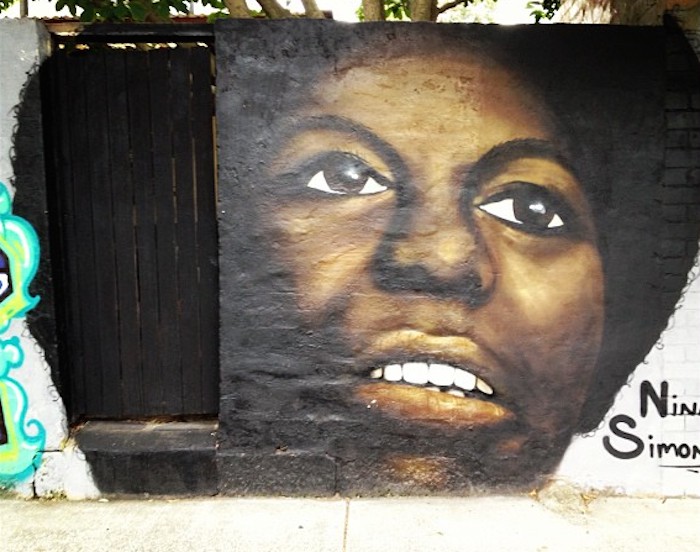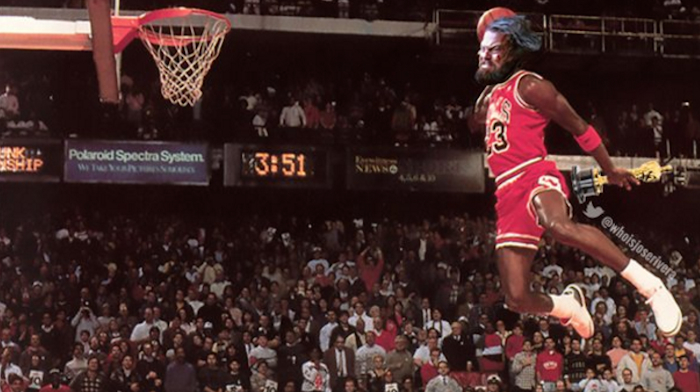The Blackness of Meme Movement
Not only can the origins of many memes be found in Black creators or online Black communities (Black Twitter, Black Tumblr, Black nerd culture at large), memes appear to model the circulatory movement of Black vernacular itself.
Daniel is dead. And by the time this reaches publication, Papaw and Mr. Krabs may also be long in the ground.
Such is the accepted lifecycle of memes. Memes inspire a frenzy of fun that in turn contributes to their own tragic demise. Not all memes receive the supernova treatment, of course; and meme death does not prevent reappearances in uncomfortable and interesting ways. Some, by fate or like magic manage to extend their life, morph between forms from image–text-emoji and rather only retreat than disappear entirely. Then there is a special class of memes that steady circulate the webosphere: Crying Jordan is all-ubiquitous, right on time, and utterly mobile.
Plenty have endeavored to plot a meme’s life, usually reliant upon Google analytics and/or sniffing out origins in pursuit of narrative. These tell a story of phenomena post-event, yet when it comes to meme endurance, mapping a timeline seems insufficient to address the cultural not-yet artifact, its living nature. Michele Coscia’s work importantly moves off the narrativizing track, describing collaboration between memes as a process integral to a meme’s success. In search of concrete behaviors, Coscia follows the “measurable footprint” of memes and visualizes the means by which they compete and integrate: “meme” was, after all, coined to apply evolutionary theory to the spread of culture.

Photo CC-BY Science Museum London.
As with other quantitative methods, presenting meme movement thusly requires the measurement, than standardization, than (re)colorization of cultural description. A clichéd grudge from the humanities to well, everyone else is the lack of the human in quantitative methods; in this case, something about the treatment of online memes as genes allows a comfortable obfuscation of human participation in cultural phenomena that still–for now–relies on humans to exist. As I’ve previously discussed in the context of memes and respectability politics, we often talk about memes in ways that relegate agency to the memes themselves. Gestures to an elusive “zeitgeist” type mysteriousness to fill in the cracks makes the ghostliness of that absence visible.
In the case of memes, there’s blackness in that ghostliness. It is a long fact of Black cultural production that our creative endeavors are always at risk of being severed from the community that wrought them. Not only can the origins of many memes be found in Black creators or online Black communities (Black Twitter, Black Tumblr, Black nerd culture at large), memes appear to model the circulatory movement of Black vernacular itself. Black folks are hardly the sole proprietors of internet memes, yet it’s undeniable that memes at their liveliest–that is, what allows them to keep living– is in fact indebted to Black processes of cultural survival.
Blackness and memes
We know that internet culture depends on Black people. We know that, much like culture at large, the internet circulates and derives capital from content created by my skinfolk; that in the tenuous trade of meme profiteering, the actual authors remain largely absent from the monetary benefits of their own creations. We know that a lot of popular memes employ diasporically Black vernaculars. That Black language itself works as a sort of metastasized meme, seized by non-Black entities and replicated (not so clumsily, anymore) to gain access to a kind of mass appealing Cool.
And yet, there’s something wholly unsatisfying in merely identifying at piecemeal the grammatical components that compose meme text or textual memes. For one, it feels too much like adding armaments to Master’s house, like selling a secret. The painstaking explanation of copula deletion and multiplicable negatives, the definitions given again and again seems a service destined to be exploited. Culture need not be accessible to everyone.

As a methodology, sentence diagramming memes in its own way obscures the nontextual cultural language behavior inherent to meme circulation and survival. Memes not only contain components of Black language, gravitate towards a Black way of speaking, but in their survival latch onto Black cultural modes of improvisation to move through space and subsist in an ultra-competitive visual-verbal environment.
Simply said: the way memes change, adapt, fold into themselves, make old like new… their movement looks very very Black.
Black language
This point seemingly reeks with essentialisms. “Black language”? “Black way of speaking”? What about a vernacular makes it Black is tricky. The question pries the innards of what constitutes culture — where does it live, what are the boundaries, what happens when it no longer lives in the same place or looks like what it was. Much of ‘70s research on Blackness in America was saddled with disputing an intellectual legacy and mythology around Black culture as the almost-but-not-quite assimilation of a race who debarked onto this land a virtual tabula rasa for the absorption of Western European beliefs and expressive forms. In the context of language, this meant asserting, contrary to both fin de siècle standardization practices and later post-segregationist educational policy, the coherence of structure within Black language as both evolved West African iteration and adopted (but not bastardized) English.
Decades since have necessarily loosened that insistence on origins that in its own way obscures the humanness in language as it lives in specifically adapted dialects, patois, and creoles amongst peoples across culturally variant locales yet is also socially identifiable in aspecific usage. Not every Black person speaks the vernacular, the vernacular isn’t limited to just Black people, and its resemblance to otherwise precariously-bounded language (Standard English, languages in West Africa) may tell us less than we think about how it resides in its current locale.
This messiness all codified in my usage of “Black language”: a language that lives in the people, even when those people operate within the bodiless abandon of cyberspace. Black language as much ascribes a community as a grammar; is a diction, a style, a politics all at once. Within networks of peoples unified but by no means defined by racialization, Black language is spoken, written, gestured, intuited, and invented. Within those networks and amongst those people is where its innovations arise, destined to (re)surface and disperse.
Nina Simone and the Crying Jordan

Photo CC-BY JAM Project, cropped.
In her seminal work Talkin and Testifyin: The Language of Black America, Geneva Smitherman describes Nina Simone’s sung “it bees dat way sometime” as a “total expression” of “Black English style.” There is the habitual verb ‘be,’ with a grammatical, temporal function that, again, I have no desire to rehearse. Then there is the “point of view” or “method” of the statement itself that reflects an enduring cultural refrain amongst a folk continuously marginalized in this way in this space.
How “it bees dat way sometime” in 1967 is also “It be like that sometimes” in 2016 is also indicative of Black [English] style. In this case, retaining a certain grammar says more than the grammar itself; the layering of meaning in the accumulation of a phrase that’s stayed with us yet moved, transformed into a similar and different “sometime it be like that”–now-feeling and impossibly old at the same time. It is a process shared by language and culture at large, explains how it generally takes at least four hundred years back into the English canon for students to really struggle with diction and syntax. How Black Lives Matter, in all its diverse iterations, can’t escape the remnants of earlier 20th century pro-Black movements. How early twenty-tens fashion looks a lot like the 90s with a twist. How earnest “slang”–generally appropriated Black vernacular–from the past resurges semi-ironically in the now: dope, clutch, down, jam.

Even as by definition anything called culture is constantly in a patchwork process of (re)making itself with old material, the survivalist maneuver performs most importantly amongst a tradition that knows itself to be up for grabs in a certain way, that must always be made anew but never lose itself. Memes in many ways inhabit that survivalist measure. As they mix and merge, we get a glimpse of a more meditative moment within the impossible speed of internet hypertime. Much like shitpics, meme mash-ups are evidence of human touch. A moment when someone chooses to pass along a Thing in a form more hip than the original. In a nutshell, signifyin(g).

Crying Jordan then is–for now–the meme extraordinaire. Crying Jordan survives as a trope so versatile to be predictable, comfortable. It remains in threadbare attachment to its origins–Jordan’s 2009 Hall of Fame induction speech— and retains just enough signification–Michael Jordan as a recognizable athlete/public figure, the almost cringeworthy expression of emotion–to extend its reach beyond circulation of the one cut-out image.

(Image tweeted February 28th by @whoisjoserivera shortly after Leonardo DiCaprio won the Academy Award for Best Actor for The Revenant.)
Though it’s almost unimaginable that anything could supplant Crying Jordan anytime soon, Mr. Krabs proves at the very least to be more than flash in the pan. It has to its benefit a ripple-like visual easily translated across multiple subjects. As participants exhaust the catalogue of relatable life experiences that brought the meme its fervor, it must latch onto event(s) ascribed to the now–something that, as @FranziaFanon describes, “merits the use of it” as a particularized mode of meme expression. “It’s like the spiderman symbiote,” he continues, “it needs to find a new host.”

(Made anew but never lost.)
I’ll always be on the push to inject the human into memes, not as supplement nor counterbalance, but complementary discussion that recognizes the user agency and human creativity that is responsible for the objects we share and the sharing of those objects. If we accept that Blackness holds up popular culture, that Black language informs white lingo; if we acknowledge both the individuals and communities (Black Twitter, et. al.) that foster our most beloved internet objects, it’s not such a stretch to propose blackness as the living tissue of memes.
Considering this is the tail end of it, this essay is obviously not demonstrative of what’s advocated: excavating the blackness in memes (even ones that don’t seem so black). Ethically we might suppose familiarity with Black vernacular is a prerequisite to writing about meme culture. That wherever blackness goes unaddressed in a study of the phenomena, from cutesy etymologies to funded enterprises out of the ivory tower, new ghosts are made and old ghosts keep haunting beneath the assumed whiteness of a medium. And nobody receives credit where deserved.
Stated less contentiously, I believe attentiveness to Black language forms always enriches discussion on internet culture and thus includes memes, as an eradicable feature of internet life: looking at memes for not only the features that can be pointed to their origins, but how memes in their emergence, development, transformation, and resurgence are imbued with a semantically Black mode of improvisation and revitalization.


